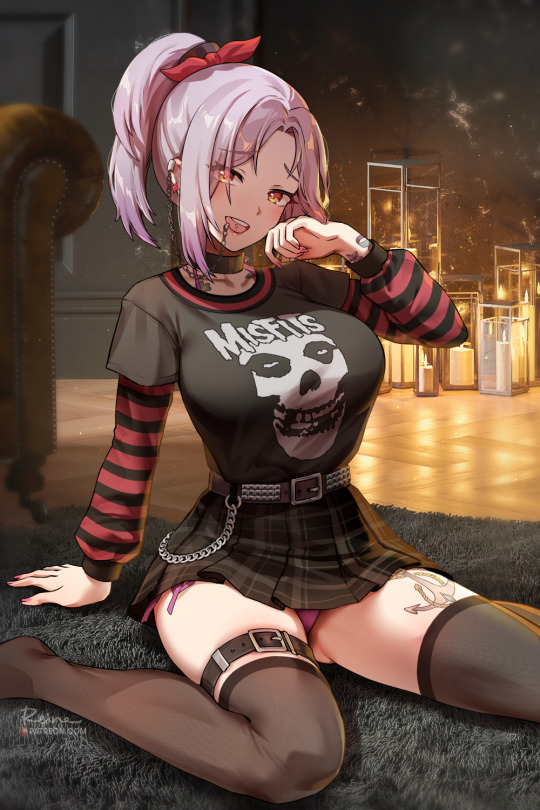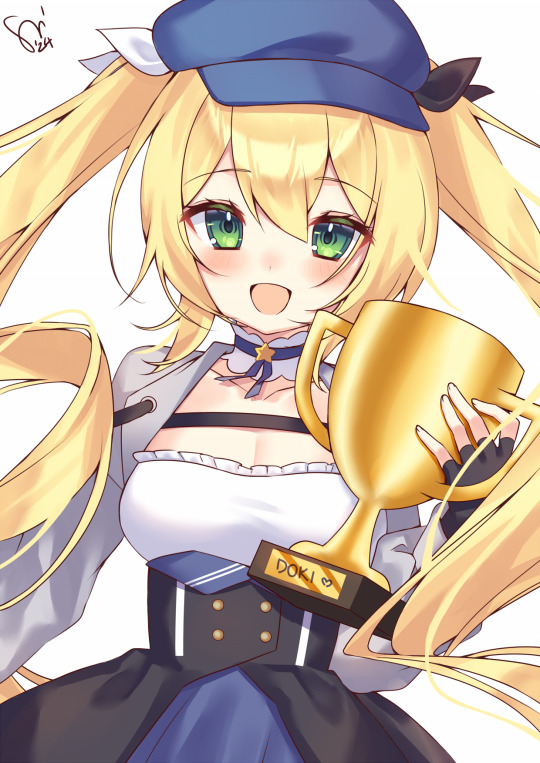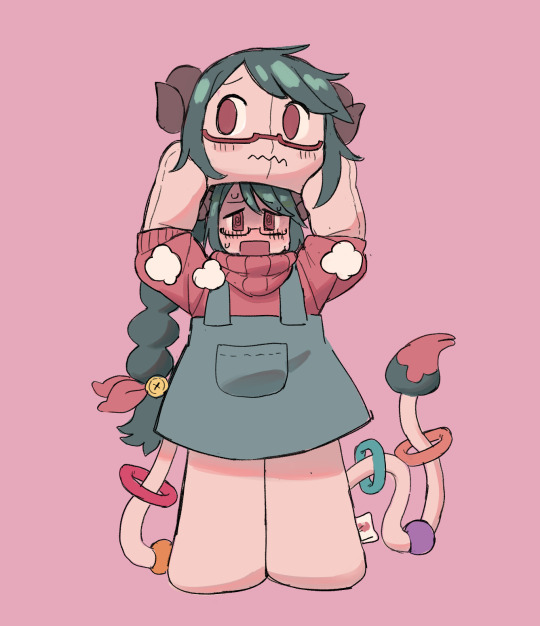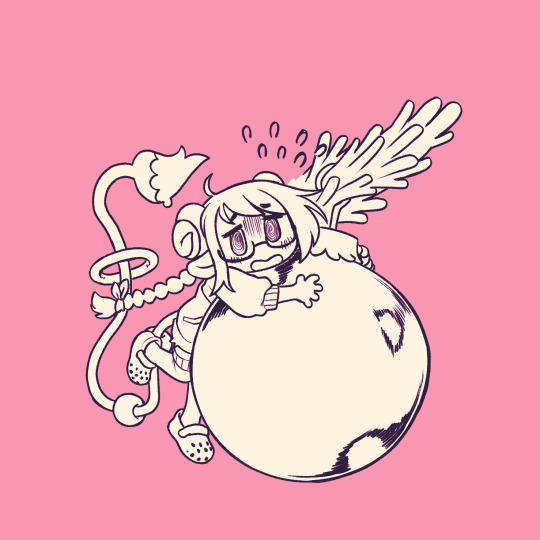#indie vtuber
Text
It's tradition.
#elden ring#snake eater#mgs3#indie vtuber#vtuber#twitch#demilypyro#stream highlight#demily#demily pyro
697 notes
·
View notes
Text

FeFe by Reine [Twitter/X]
※Illustration shared with permission from the artist. If you like this artwork please support the artist by visiting the source.
189 notes
·
View notes
Text

750 Days and more of Never-Ending Terror: Understanding the Unending Ukraine War | Full Text
Full video in the following link:
youtube
Please like, comment and subscribe if you are interest in the content I made!
My other social media links: bit.ly/m/noxxmyosotis
Introduction
Since 2014, the Russo-Ukrainian War has been a time bomb for the security of Europe, causing a great deal of suffering for the residents of Eastern Ukraine. In February 2022, Russia decided to escalate the conflict by invading Ukrainian territory, making it one of the largest scale hostilities to occur in Europe since World War II (Walker, 2023).
Despite initial hopes that the war would end quickly on both sides, it is still ongoing at the time the script was written (December 2023), which means that there is still constant bombing and threat within Ukraine's borders, causing daily suffering to both Ukrainian and Russian civilians. Although both sides claim that the other cannot hold out for much longer, there appears to be no end in sight. According to some news sources, Russia's local economy has become more precarious due to the departure of foreign investment, and the living conditions and welfare of its citizens have become more uncertain as a result (McHugh, 2023).
The situation raises two important questions: why does Russia continue to prolong the invasion war when they are not necessarily receiving any benefit from the war itself? and how is Russia able to sustain itself in a state of war, going against international communities, tarnishing its reputations, suffering intense scrutiny, and creating a chaotic political state externally and internally? Were Putin's one-man show and lunacy the only factors propelling the war forward, or were there additional structural reasons for the war to continue, despite its lack of success?
Through this essay, I wish to explore the situation of the Ukraine War through the following areas:
The causes of war and their current impact.
The impact of the war on the internal politics of Russia.
The societal conditions of Russia that allowed the war to be prolonged.
The future of the conflict and the conditions needed to end the war.
Classical and contemporary theories related to sociology of war and violence, political sociology, including the framework of organized violence will be examined. I will also consider the current account of Russian history, the unique structure of Russian society, and the theoretical frameworks, to answer the question: why the conflict has not ended?
The Prelude of Invasion Part I: The Crimean Invasion
Before the invasion towards the mainland Ukraine happened in 2022, it is important to remember the war has already been happening since 2014, when Russia annexed Crimea, a majority ethnically Russian area with a strong pro-Russian separatist force exist (Walker, 2023). At the time, most international organizations and nations took a relative neutral stance on the incident, stating that the primary cause of the annexation was local civil unrest and that Russia, and Putin in particular, should be condemned for failing to de-escalate the conflict, but not for launching an invasion.
There are several social reasons why pro-Russian ideology is particularly prominent within the region. The most significant and obvious is related to the ethnicity of the Crimean people. Despite the predominant Russian population in Crimea, the region has historically accommodated various minority communities, such as Ukrainians and Crimean Tatars. Prior to the Russian conquest in the 1700s, the Crimean Tatars constituted the majority ethnic group. Consequently, the historical context reveals a dearth of unequivocal legitimacy regarding territorial claims (Dawson, 1997).
The intricate ethnic makeup of the Crimean region emerged as the primary catalyst for tension and political turmoil inside the area. The Crimean region is characterised by a complex political landscape, consisting of three distinct factions. Firstly, there are Ukrainian-aligned parties that advocate for the further integration of Crimea into Ukraine. Secondly, there are Russian-aligned parties that aim to reduce Ukraine's influence in Crimea and increase dependence on support from Russia. Lastly, the Crimean Tatars aspire to establish an independent and legitimate ethnic state. Each faction actively pursues strategies and tactics to advance their respective goals while simultaneously discrediting the objectives of the other factions (Dawson, 1997).
Such complications are further entrenched through the fall of the Soviet Union. Following the Ukrainian parliament's declaration of independence, a significant number of individuals residing in the Crimean region expressed discontentment with the ensuing economic decline experienced by the country. These individuals drew comparisons between their situation and the more prosperous Russian economic reforms, leading them to believe that aligning with Russia would bring greater economic prosperity to both the region and its inhabitants (Dawson, 1997).
It is important to note, however, for the following decade, there is evidence where both the ethnic tension and political dissatisfaction within the region has decreased over the years. The economic situation of Crimea also significantly improved since the initial downfall from USSR by the time 2010s rolls around, and majority of the media consumed within the region were Ukrainian affiliated, with many young people stop identifying themselves as Russian and affiliate themselves with Russian culture, rather supporting a newly formed Crimean identity, while even some of the most radical Russian supporters suggest a strong preference for peace over war (Knott, 2018; O’Loughlin & Toal, 2019).
However, narratives that propose Crimea not only belongs to Russia, but would also benefit from joining Russia, hold considerable sway within mainland as well. Russian mainstream media extensively highlights the plight of individuals in Crimea, emphasising the necessity of rescuing them from both economic destitution and the unlawful occupation of their land by the government, which also discriminates against their fellow Russians while promoting an unjust agenda in the region (ForPost, 2013; Pravda, 2013; Shurkhalo, 2013).
The historical and ethnic tensions in Crimea were further intensified by the wider political situation in Ukraine during the early 2010s. This occurred as the public became divided over problems concerning the relationship between the Ukrainian government and the European Union (EU). The pro-EU movement, known as the "Euromaidan movement" after their large-scale protest in 2013, advocates for a stronger economic and social connection with mainland Europe. They also advocate for social progress and reforms, such as the inclusion of ethnic minorities and queer individuals. (Kvit, 2014). Meanwhile, the counter-EU movement, referred to as "Anti-Maidan" in reference to their oppositional protest in 2013, mostly centred around traditional orthodox doctrines, including portraying queer imagery as "western propaganda" and displaying a fervent inclination towards bolstering Russian supremacy and embracing imperialist aspirations (Makarychev & Yatsyk, 2018; Shekhovtsov, 2014).
It is important to highlight the role of social media propaganda played in pushing the agenda of the Anti-Maidan movement further. During this period, various websites, such as Facebook and Twitter, disseminated specific advertisements endorsed by the Russian government under Putin's leadership to sway Crimean voters towards supporting independence from Ukraine. Additionally, numerous counterfeit accounts and social groups were established to propagate deceptive information and construct a false narrative that portrays the interests of Western nations as inherently corrupt and incompatible with Russian identity (Demartino, 2021; NATO Stratcom, 2015).
While ethnicity and culture are important factors, the Russian government's involvement extends further. Throughout the past two decades, it actively promotes the broader ideology of the "Russian World" to counter western influences, not only to destabilise the Crimea region and other regions within eastern Ukraine, but also to shape the perception of the government and stabilise internal power structures within the mainland. Through creating a narrative that there exists an inherent Russian world that are incompatible to the west, incorporating both Ukraine and Belarus, highlighting the common past exist between the nations, while establish the need for Russia to be the centre of the hierarchy within this world, the government is able to successfully leverage its people in supporting more aggressive actions within its borders, gaining soft powers domestically to support its following imperialistic actions (Feklyunina, 2016).
In late 2013, civil unrest broke out following a prolonged period of growing tension in the local area and wider political scene, driven by Russia's clear intention to disturb the region. The disturbance was further instigated by the former President Yanukovych's rejection to ratify agreements with the EU because of Russian influence. Over the subsequent months, there were confrontations between Euromaidan and Anti-Maidan organisations across southern and eastern Ukraine, with occasional instances of violence (Euronews, 2014; Salem et al., 2014). Shortly thereafter, Russia opted to intensify the situation by deploying its military to bolster the independence movement in Crimea, thereby commencing the initial phase of its continuing incursion into Ukraine, marked by the annexation of the Crimea area.
The Prelude of Invasion Part II: From “Russian World” to “Russia’s World”
The annexation of Crimea prompted swift and unfavourable reactions towards the Russian government from Western countries, notably the United States and the European Union. These responses primarily involved two actions: firstly, bolstering the alliances among NATO nations and enhancing NATO's military capabilities along the eastern border; and secondly, imposing economic sanctions on Russia (Pifer, 2015).
However, both efforts have only been resulting in limited success. The annexation of Crimea cast shadow on the previous efforts and the overall effectiveness of NATO, while highlighting the failure of NATO to actually provide regional stability to the eastern Europe, allowing the general public to cast doubt on the necessity of NATO and military actions while being fearful of further Russian retaliation (Gardner, 2014; Simmons et al., 2015). Meanwhile, Western firms have shown tepid support for the sanctions, either seeking loopholes or openly defying its implementation. Moreover, the validity of the penalties is routinely contested in international courts. Meanwhile, Russia has chosen to enhance its collaboration with its eastern allies, including China and ASEAN nations (Paul, 2017).
Although Russia is less affected by exterior influences, the internal political landscape rapidly changed following the crisis. Within the dominant demographic, who are swayed by the state-controlled media and constant exposure to official propaganda, there is a significant level of endorsement for the annexation of Crimea. This has consequently bolstered Putin's popularity and solidified his reputation as a formidable leader who is unyielding in the face of adversaries (Stoycheff & Nisbet, 2017). In the meantime, the response from the west has also been framed as a deliberate attempt to delegitimise the Russian identity, allowing Putin to rally individuals to overlook the potential economic problems and humanitarian issues posed by the act of annexation (Gerstel, 2016).
During the same time frame, Russia's official position on matters concerning Ukraine underwent a significant and abrupt change. Initially, the Russian officials advocated for safeguarding the rights of Russians within Ukraine's borders, while also acknowledging the autonomy and choices of other Ukrainians. However, following the invasion of Crimea, the Russian officials swiftly portrayed Ukrainians as consistently hostile towards Russia and individuals who identify as Russian, emphasising the religious and cultural differences between them (Strycharz, 2022). Even the most severe critics acknowledged that the annexation of Crimea is not fundamentally erroneous, but rather questioned the methods employed by Putin to obtain it, leading to minimal dispute regarding the legitimacy of the annexation inside Russia as a whole (O’Loughlin & Toal, 2019).
As support for the integration of Crimea strengthens, the internal politics of Russia are becoming more cohesive. However, tensions within mainland Ukraine have been escalating since the occurrence. The supporters of the recently established government comprise various fragmented factions. Most of these supporters align with the left-wing of the political spectrum, advocating for political and personal rights. Nonetheless, there is a significant minority of far-right individuals who sympathise with Neo-Nazi ideologies and endorse the dominance of Ukrainian culture to counteract the influence of Russian identity. The friction between these two groups escalated rapidly as the latter exhibited growing hostility and alienation, frequently leading to hate crimes. This became a major issue for numerous ethnic minorities residing inside the borders of Ukraine (Saluschev, 2014).
Meanwhile, many anti-Ukrainian government organisations, predominantly situated in Eastern and Southern Ukraine, observed the triumph of the Crimea's annexation, and subsequently initiated the formation of their own armed forces. The Donbas region experienced significant protests in March 2014, triggered by the annexation of Crimea and the inclusion of members from the anti-Russian Svoboda party in the new government. The Svoboda party openly identifies as Neo-Nazi, causing concerns about potential discrimination against the large population of ethnic Russians and Russian speakers residing in the area (Clarke, 2016).
The Russian government took advantage of the turmoil in Ukraine and the widespread support for the annexation of Crimea to quickly provide military assistance to the independent movements in the Donbas region, thus starting the Donbas war. By endorsing these initiatives, Russia rapidly consolidates its position as the saviour against Ukraine and the West, advancing the agenda of the "Russian World" even further (Matveeva, 2016).
It is crucial to acknowledge that the Russian government at that point of time had minimal or no intention of launching a full-scale war against Ukraine. Instead, they are exploiting the existing instability in the region. This is evident from their initial decision not to immediately use military force in the Donbas region. Even when they did engage, most of their forces were involved in intelligence and communications activities rather than direct combat (Robinson, 2016).
The war of Donbas, which officially concluded in early March 2015, resulted in a temporary cessation of hostilities in the region. Nevertheless, even after the signing of official treaties and the agreement on peacekeeping measures, there were ongoing minor conflicts in the region. It has been speculated that many Russian militants have become integrated into independent movements in the region, thereby enabling Russian forces to perpetuate instability. (Robinson, 2016).
While the major conflicts had been resolved and would not resume until five years later, the circumstances of the Crimea and Donbas regions were permanently altered. The economic conditions in the affected areas were severely damaged, leading to the destruction of profitable industries like mining and oil. Additionally, many refugees were compelled to leave their hometowns and seek shelter in either Ukraine or mainland Russia. Unfortunately, these refugees faced challenges on both sides. In Ukraine, they were often viewed as potential threats to national security, while in Russia, they were frequently used as political pawns to reinforce the narrative of Russia's superiority over the West (Giuliano, 2018; Rimpiläinen, 2020).
How it all started: War as an intentional act of Russia
While the Donbass and Crimea territories played a significant role in the hostilities and offered valuable historical and cultural context, they were not the only causes of the full-scale invasion that took place years after the initial peace treaty was ratified. In the western media, the primary attribution for the invasion is frequently assigned to Putin himself, along with his inner circle of political and military confidants. Putin was widely perceived as the mastermind and prominent figure behind the invasion, and his absence would have had a profound impact on the situation in the Russo-Ukraine region.
Undoubtedly, Putin exerts significant influence on the invasion, driven by his personal motives and strategic calculations. Putin's previous experience in the Kremlin has shaped him into a perpetually power-hungry individual who constantly seeks to tighten his control over everything. Through long-term propaganda efforts, he has been portrayed as a strong leader, effectively suppressing critics and independent media outlets; the political infrastructure established during his presidency also ensures that people prioritise appeasing Putin's personal beliefs and emotions above all else (Rochlitz, 2015).
Nevertheless, the invasion cannot be only attributed to Putin's insanity, but rather stems from the intricate workings of the Russian state. As previously shown, Russian attitudes towards Ukrainians have undergone a notable transformation. Initially focused on Crimea and the well-being of Russians within the area, these attitudes now encompass a broader perception of Ukraine as a symbol of the West and a source of existential anxiety for Russian national identity. Although the state's top-down propaganda may partially account for it, this explanation alone is inadequate to justify why the war was widely regarded as the preferred solution to the cultural clash, without considering the active role of the Russian population and their impact on the state's decisions.
To look for reasons beyond personal and cultural reasons, one theoretical framework we can investigate is the theory of organisational materialism. Charles Tilly, a prominent scholar who developed the theory, stated that war is a vital component of the state's function within the framework of organisational materialism, as it serves as an effective mechanism for social control, state expansion, capital accumulation, and resource extraction (Tilly, 2012). Furthermore, organisational materialism scholars argued that modern state-building is a consequence of war, where the distinction between allies and enemies is defined by national borders, while it also leads to cultural changes through war-related activities and promotes the development of institutions like legal systems and financial structures, which enable the state to consolidate power (Malešević, 2010).
Such principles can be easily observed through the actions of Russia, particularly in relation to Ukraine. Throughout the years, as Russia grew larger interest within the Crimea region, the need to distinguish between what is Russian (i.e., those who live and shall live under Russian rulings with the centralised Russian state) and Ukrainian (i.e., those who are opposing the Russian state) through national borders signified, hence the birth of the concept "Russian World," opposing the idea of the "Western World." The annexation of Crimea and the invasion of Donbass further push the idea that the Russian state has a legitimate monopoly of violence over the ethnic Russians, consolidating cultural power with the political power that the institutions hold over the people within the region.
In addition to expressing military power and consolidating political power through the explicit demonstration of violence, it is important to be reminded that the legitimacy of the state often comes also through economic activities and ideology supremacy over the individuals (Malešević, 2010). Sociologist Michael Mann has argued that modern statehood is established through a process he calls "social caging," in which the state imposes restrictions on individual freedom in return for economic stability and military protection, which leads to long-term social stratification and institutional centralisation (Mann 1982, as cited in Malešević, 2010).
The process of social caging can be easily observed within Russian society after the invasion of Crimea. Immediately after the annexation, the West quickly responded by imposing sanctions against the Russian economy. However, instead of pushing extra pressure against the Putin government, it was able to spin the narrative that the sanction is meant to "humiliate and weaken Russia," rallying people to fear the existential dread that is the EU (Gerstel, 2016). Seeking protection from the external threat, the approval rating of Putin increased in the immediate months after the annexation, which in turn allowed policies that strongly restricted the rights of individuals in terms of freedom of speech, immigration around the border, and military conscriptions, as well as increased military actions and plans within the western end of the border.
Nonetheless, organisational materialism could partially explain why war is an ideal method for social control and reinforcement of the power of the state but lacks justifications as to why many individuals within Russian society are enthusiastic about the war and willing to sacrifice themselves, hence legitimising war as a strategy. Hence, beyond recognising the coercive nature of the state, it is also important to recognise how citizens within the state internalise such ideas and form cohesive ideologies that they believe in.
The connection between ideology and war is frequently described as a "manifestation of consensus," where individuals associate their habits, customs, and traditions with the communities and institutions around them. This leads to labelling those who do not follow these actions as "others" outside the community, giving institutions and communities the authority to use violence and oppose change in the name of self-defence. Moreover, modern warfare was further legitimised through the breakdown of traditional communities and media sensationalism, where individuals often feel extra vulnerable, needing protection from a greater force, and the connections transcend their personal experiences, allowing the rise of nationalism and exceptionalism within the boundaries of the state (Trepanier, 2018).
The ideologies of the Russian state are hard to define, but it is easy to identify why individuals associate with them in the events leading up to the invasion. The remanent of the cold war from the USSR times still lingers amongst the elder generations, blaming the downfall of a once glorious empire on the influence of the west, while the "western-centric" worldviews constantly defy their own cultural upbringings and understanding of normality, pitting them to believe that the westerners were the "others," and within an environment where social stability often could not be guaranteed, in particular after the long stagnation of economic situations since the 2008 financial crisis, all making individuals vulnerable to ideological propaganda that proposes the west against Russia and the need to establish a "Russian world".
From then on, support for the war was born. In the simplest summary, beyond Putin’s personal will, the need for stability and structure in an unstable time allowed individuals to give in their personal freedom towards the state, which further legitimised the acts of violence that the institution committed, allowing the state to push war onto those who were “others” and consolidate resources to benefit itself. The war is beyond a coincidence or a madman’s choice, but a rational and intentional choice of the state to preserve itself at the cost of people both seen as others and individuals who belonged to the state.
The Red Square Never Falls: The Never changing Russia.
Earlier, we explored how the geopolitical climate contributes to the likelihood of conflict and Russia's intentions in supporting the war prior to its initiation. However, it is crucial to analyse why Russia has not altered its attitude while facing external pressures like sanctions, public censure, and internal political turmoil to answer the question: Why is the war still going on?
Western countries responded to the invasion in three ways: providing direct military assistance in the region, imposing economic restrictions on Russia's economy, and engaging in information warfare on online media platforms. Although these factors influence the war to some extent, none of them can significantly create a powerful enough force to change the conditions of the war to the point where Russia would agree to a ceasefire.
The direct military assistances perhaps were the easiest to argue why it failed to become the tipping point for the end of the war. While countries within NATO, particularly the US, UK and Poland have provided supports in terms of both spendings and machinery towards Ukraine, the response from Russia resulted in extra militants, including Syrian mercenaries and the Chechen troops, to further engage in direct combat against the western support (Singh, 2023). Though many speculate that Russia has been draining all its military power in dealing with the Ukrainian army supported by the west, it is important to note that the support has also been in the danger of drastically decreasing due to both the domestic political contention within both the US and the UK and the normalisation of the issue over the years, meaning less awareness channel and political support for future Ukrainian aid (Chivvis, 2024; Kaarbo et al., 2023).
Even from a historical perspective, military aids rarely became the factor that drastically deescalate the status of the war. Previously in Iraq, the continuous military backing provided by the US to the government led by former Prime Minister Maliki resulted in heightened oppression of the Sunni ethnic minority, leading to further uprisings in Sunni majority areas. Boutton (2021) argued that military aid often creates incentives for regimes to rely on the military aids to survive the fallout, and become more aggressive in their own actions, leading to more instability and insecurity for individuals.
In the Ukrainian war, military aid has been beneficial in resisting the Russian invasion, but it is unlikely to be the decisive factor in altering Russia's strategy. The clear attitude of Putin is that the war should be prolonged, regardless how grand the cost is, as it serves justice in resisting the western control over the "Russian World". As previously identified, the people's support for the war is influenced more by cultural and ideological factors rather than by belief in Russia's military capability. Therefore, Ukraine's military strength has limited impact on popular opinion about the war currently.
The sanctions and pulling out of companies seemingly have an impact on the Russian economy at least. According to Ahn & Ludema, (2020), the companies of Russia, especially those that are in industries that are targeted, have a significant loss in terms of both revenue and assets. In addition, the sanction has also been projected to stagger the long-term growth of Russia, while Russian retaliation has shown limited effect in countries outside its immediate neighbours and could hurt themselves more than other countries (Hosoe, 2023).
However, despite the negative effect of western sanctions, it is unclear that sanctions contributed to the anti-war sentiment in the Russian society. Historically, sanctions have often been framed as a tactic used by an "evil external aggressor," and the inner opposition can then be prosecuted as the supporters of the aggressor. In addition, the economic effect of the sanction is often transferred to the already economically stricken, further fuelling their anger towards the opposition (Pala, 2021). Connecting such sentiment with the strong, ideological belief that the "Western World" is an inherent opposition against the "Russian World," it would not be hard to understand why many believed that the purpose of the sanction was to weaken Russia and hence curate more support for the government in its strong stance.
In addition, the sanctions could not be useful so long as the Russian government believed that they would not be sustained, and there are alternatives to circumvent the issues that the sanctions will cause. Since the initial sanction has been in place, Russia has been active in funding independent financial institutions and actively drawing funding from alternative sources to counter the influence of the US and EU (Ashford, 2016). At the same time, the popularity of the sanction has also decreased over the years, with many people, though they still broadly support Ukrainian causes, now hesitant to support the sanction as concerns about cost and priorities emerged (Chivvis, 2024).
Beyond direct military conflict and economic sanctioning, social media emerges as the new battlefield of information between the West and Russia. Even before the annexation of Crimea, Russia has been purposefully spreading propaganda in online social media spaces such as Facebook, Twitter (now X), and regional medias such as VTontakte and Odnoklassniki (Demartino, 2021). Since the annexation, the Russian government has been purposefully curating narratives within social media spaces through awarding Kremlin-aligned media posts, fabricating false news events, and controlling Internet trolls to contaminate legitimate discussions (NATO Stratcom, 2015).
In the meantime, the West has been employing tactics to counter the narratives of the Russians. The way narratives spread in the west, in contrast to Russian media, has been largely decentralised, mostly with individuals who do not share apparent relationships with the government, sharing their personal stories, and creating genuine connections with their audience to illicit emotional and empathetic responses. In addition, as the Ukrainian president Zelensky previously worked within the entertainment industry, the experience has also allowed him to be naturally appealing on camera, generating apathy amongst the viewers (Ciuriak, 2022).
The social media stories have been effective in influencing the decisions of people on both sides. The narratives pushed forward by pro-Russian media, including those that defame the International Monetary Fund (IMF), the EU, and the current Ukraine government, have been shown to have a strong correlation with showing a neutral or negative attitude towards policies supporting Ukraine, though whether the narratives are the direct cause of support is unclear. (Maschmeyer et al., 2023). Simultaneously, using platforms such as Facebook groups, people from the west are able to bond through the traumatic experiences and heal mental health through verbal expression (Zasiekin et al., 2022).
Though the high visibility of information generated awareness of events across the world, whether social media can generate crucial momentum changing the direction of war is unclear. Social media, despite being vast and diverse, is a highly segregated space where people share similar sentiment often only view, comment and share information which reaffirm their previous beliefs, creating strong echo-chambers (Cinelli et al., 2021). Even when interactions happened, they have often resulted in arguments which strengthens their own belief that the opposing party often is unreasonable and irrational, further polarise the online communities apart (Gillani et al., 2018).
Within the context of the Ukraine war, with many individuals within Russia already supporting the Putin-led government and the right-wing sentiment surrounding the narratives proposed, in addition to the language barrier, they are more likely to stay within the information bubble filled with Russian propaganda rather than interacting with stories from the perspective of the west in a rational and open-minded manner. Furthermore, as the war has been intrinsically linked to the national identity of individuals, many of the communities have actively blocked the existence of potential outsiders who do not partially or completely identify with said group, further locking away opportunities to engage (Abramenko et al., 2024).
Worsening polarisation is the censorship, either by the Russian government directly or by the self-censorship of the Ukrainian supporters within Russia. Through threats, forceful blocking of certain sites, and criminal charges, individuals are often forced to silence their voice to protect their safety and that of those who are around them (Rudnik, 2020). Many of these supporters then subsequently migrated out of Russia, further preventing them from voicing their opinions from within the country.
With most tactics failing to change the status of the war, it is natural to wonder: Will the war ever end? Especially after 10 years of never-ending back-and-forth with no mutual agreement in sight. Will the war be a perpetual state that individuals within Ukraine, particularly those who live in Donbass and Crimea, must endure?
The Light at the End of the Tunnel: The Future of the war
Though it is easy to be pessimistic as negative news constantly pops up on media channels, there are some optimistic aspects to the situation in the war. In recent history, most wars ended with a peace agreement or a ceasefire after a certain period, and often, the weaker actors ended up being victorious in defending themselves against the stronger actors. In the meantime, peace agreements and ceasefires often last for a sustainable period, where the tensions between parties eventually cool down and resume normal (Lieven, 2022).
The prerequisites for achieving peace can be categorised into three levels: the systemic level, the society level, and the individual level. The framework, called the levels-of-analysis framework, argues that these levels are interconnected and can influence each other during the process of ending a war, though the incentive to reach peace on one level does not necessarily lead to a positive outcome on another (Levy, 1998).
From a systematic standpoint, as previously said, the war was started because the advantages that come with it are greater than the advantages of peace, such as the consolidation of power and the exploitation of natural resources by the Russian government. Military capability is often seen to stabilise existing coalitions that were disrupted by outside forces, and war is needed for the system to restore equilibrium (Levy, 1998).
Through this point of view, peace can be achieved, or at the very least anticipated, when it ceases to function as a stabilising force and instead actively contributes to instabilities inside a nation, both internally and externally. As time went on, the return of war became increasingly marginal in contributing to the stability of the Russian government. The direct financial cost of the war, compounding with the decrease in oil prices and western sanctions, means that the war has become increasingly expensive over time, while Russia is expected to enter a recessionary period soon (Liadze et al., 2023).
In addition, the events related to the betrayal of the Wagner group, alongside the assassination of Navalny, all reinforce the existing fear and instability within the society as a direct consequence of war. Compounding with the fact that Russia has yet been successful in capturing Ukraine at the rate they expect, with many towns and cities recaptured by Ukraine, individuals are increasingly afraid of getting drafted by the military, generating negative attitude towards the government (Nechepurenko et al., 2023). Meanwhile, the immediate rise of government support due to the initiation of war has traditionally died off over time, as people losing trust in the ability of the government in protecting them, and increasingly traumatised by the war itself (Hong & Kang, 2017).
Beyond the structural implications of war being unsustainable over a long-term period for Russia, the societal attitude of the elites has also been shifting since the start of the war. As previously seen, the initiations of war were often the result of scapegoating and othering of a certain group, creating a divisive force amongst individuals. However, Snyder (1991) has argued that the elites, who perpetuate the divisive wars, often have different interests in mind, and if the regime tried to overexpand their power, the internal collision would fall apart as many of them stopped benefiting from the over-expansionist policies with the resources they ought to provide.
We could observe such a fall of grace in action in the event of the betrayal of the Wagner group. For a long period of time, the Wagner group and Prigozhin functioned as a part of the Russian army in exchange for political favour from Putin and lucrative monetary incentives the invasion provided. However, as time went on, the mercenary group could not see the war end in sight, causing a significant increase in the cost of providing people. In addition, Prigozhin has become increasingly frustrated with the Russian government bureaucracy, even going as far as directly clashing with the Ministry of Defence himself. Subsequently, as the benefit of participating the war on Putin’s side became increasingly marginal, Prigozhin decided to turn on Putin, hoping the war could be ended sooner with his actions (Gurbanov, 2023).
Although the insurrection ended with Putin successfully rising to power and being able to prevent the coup with the help of Belarusian President Lukashenko, it did demonstrate that the Russian elites do not have a uniform view on the status of war, and should the war drag on, the more likely Putin is to face infighting amongst his own cabinet, which creates factions that generate instability within society.
With instabilities and infighting on both structural and societal level, it is hence easy to observe individuals changing their position in what is best for their interest. As time went on, the enthusiasm of war on Ukraine has died down domestically, with increasing amount of young individuals being sceptical of the Putin regime, and vast majority of the individuals oppose a second wave of mobilisation in military actions (Milov, 2024).
It is crucial to note that war is often unpredictable, and geopolitical tensions can change drastically within the span of months or even weeks. However, there is hope, as though the war is currently sustaining itself; whether it could sustain itself in the longer term seems increasingly questionable as it drags longer.
Conclusion: When the Snow Stops
The war has been going on for two years, or around ten years, depending on what you define as the starting point. Countless individuals lost their lives in the process, and countless more were traumatised, forced out of their communities, lost their ability to conceptualise the horror and grief they face, and altered their life trajectory forever.
There is no real way to heal unless the horror stops. Regardless of where you are or who you are, being constantly reminded of a war that seemingly has no end does not bring hope. It is easy to open social media and wonder, "What is wrong with the current world? Will the world ever be normal again?"
In the essay, I have investigated the historical and cultural reasons behind the war, the sociological reasons that allowed the war to be initiated and prolonged, and most importantly, whether there could be an end to the war. Through this, I seek to provide insights that not only help people rationalise what they see and hear about the Ukraine war but also provide hope. The hope that the war one day will end, and there is a glimpse of a light on the horizon, and a chance that the world can resume to normal, at least in relation to the Ukraine war.
There needs to be hope because it is hard to fight without any hope. However, even with only a glimpse of hope, people will continue to fight against injustices and make a better life for themselves and those around them. This is no less true for people at wartime. I hope the essay is beyond informative, but also provides hope to those who may have lost it, to say to them "Keep on fighting."
There is nothing better to end the essay than a poem by Ukrainian poet Lesya Ukrainka. Composed in the 1890, it illustrated the author’s strength, despite her unfortunate political persecution and bodily circumstances. It is one of the most hopeful and beautiful pieces of poetry, and I hope it grants you strength.
Thoughts away, you heavy clouds of autumn!
For now springtime comes, agleam with gold!
Shall thus in grief and wailing for ill-fortune
All the tale of my young years be told?
No, I want to smile through tears and weeping.,
Sing my songs where evil holds its sway,
Hopeless, a steadfast hope forever keeping,
I want to live! You thoughts of grief, away!
On poor sad fallow land unused to tilling
I'll sow blossoms, brilliant in hue,
I'll sow blossoms where the frost lies, chilling,
I'll pour bitter tears on them as due.
And those burning tears shall melt, dissolving
All that mighty crust of ice away.
Maybe blossoms will come up, unfolding
Singing springtime too for me, some day.
Up the flinty steep and craggy mountain
A weighty ponderous boulder I shall raise,
And bearing this dread burden, a resounding
Song I'll sing, a song of joyous praise.
In the long dark ever-viewless night-time
Not one instant shall I close my eyes,
I'll seek ever for the star to guide me,
She that reigns bright mistress of dark skies.
Yes, I'll smile, indeed, through tears and weeping
Sing my songs where evil holds its sway,
Hopeless, a steadfast hope forever keeping,
I shall live! You thoughts of grief, away!
Lesya Ukrainka (1890), translated by Vera Rich (2009)
#sociology#galacticlibrarian#videoessay#academia#ukrainewar#education#vtuber#vtuberen#vtuber uprising#indie vtuber#Youtube
52 notes
·
View notes
Text

💜
#art#my art#artists on tumblr#digital art#drawing#vtuber#indie vtuber#envtuber#vtubers of tumblr#pngtuber#witches#witchcore#witchy vibes#witch community#cute#adorable#cuteness#cute stuff#oc#oc art#ocs#my ocs#original character#furry#furry art#sfw furry#furry oc#furry fandom#anthro#anthro art
23 notes
·
View notes
Text
FOUND OUT THAT DARKSIDERS STORES ALL ITS CUTSCENES AS VIDEO FILES AND YOU CAN EASILY REPLACE THEM
#DARKSIDERS#BREAKING BAD#PENIS MUSIC#HOW IS THIS REAL#HOW WAS I ABLE TO DO THIS#INCREDIBLE#kyriathanatos#twitch#vtuber#indie vtuber
4K notes
·
View notes
Text

comm for CallieCalicoTV in her new swimsuit 🐯💛
662 notes
·
View notes
Text

we heard u like fat himejoshi bitches >:3c
#original#vtuber#idrewaweirdcat#demon girl#cat girl#monster girl#envtuber#indie vtuber#a weird cat drew this#oc#cyan#andoufart#andou
640 notes
·
View notes
Text

today is bon day!! 🍻
got to make this illustration to celebrate @bon73P 's bday and to promote their recent donothon streams!! forever grateful for the opportunity 🙏 bonchan kyawa !!!
618 notes
·
View notes
Text

welcome back dokibird!
505 notes
·
View notes
Text



Some of my favourite Marigold's I've gotten from @chimeracauldron. Tysm again! Go follow her!
534 notes
·
View notes
Text
Bilingual Besties
#splatoon 3#splatoon#inkie heart#indie vtuber#vtuber#twitch#demilypyro#stream highlight#demily#demily pyro
268 notes
·
View notes
Text

DokiDebut by Phaethon [Twitter/X]
※Illustration shared with permission from the artist. If you like this artwork please support the artist by visiting the source.
303 notes
·
View notes
Text

comm for @demilypyro! very funky
656 notes
·
View notes
Text
how i speak 3 languages in the languages i speak
everyone else: wow your english is good! like native!
americans: i know what you are 👁️👁️
Twitch | Comms
298 notes
·
View notes
Text
made a silly lowpoly madol of izzy @belbeeps's chat mascot!
#lowpoly#3d#3d lowpoly#3d art#artists on tumblr#vtuber#envtuber#belbeeps#squirmie#wyrmworld#twitch mascot#indie vtuber#mascot
199 notes
·
View notes